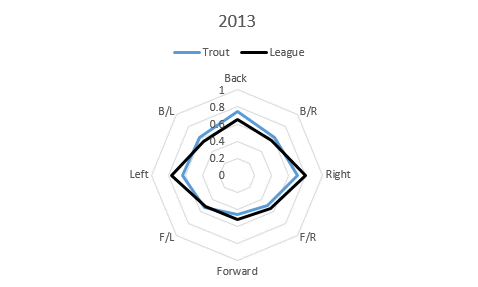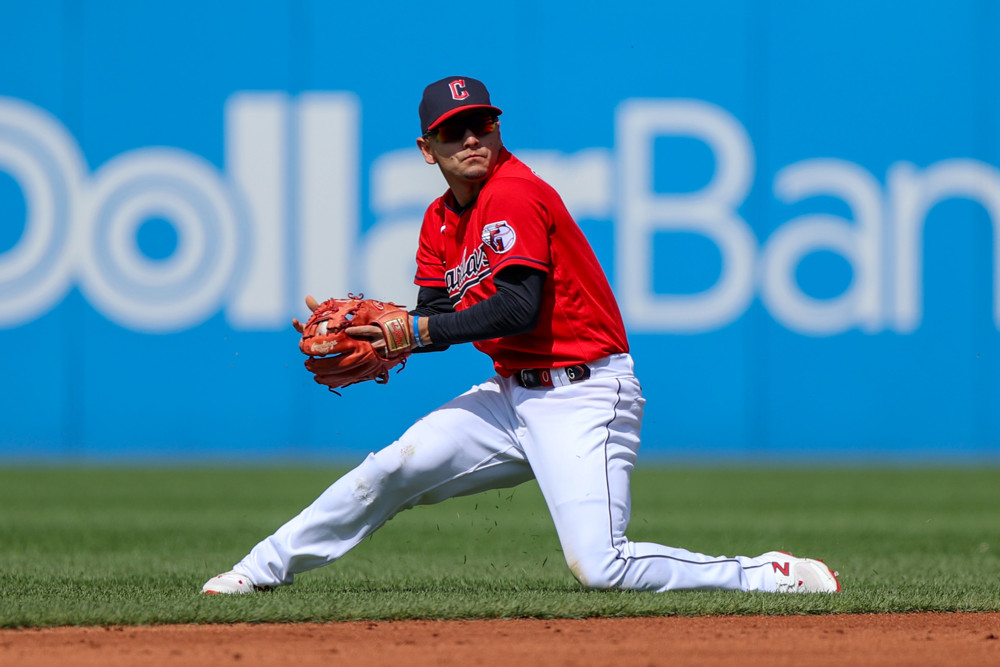“Five-tool player” is a term that gets thrown around in baseball circles a bit more than it probably should these days, but one player we can unequivocally agree who fits that mold is the man patrolling center for the Angels most nights: Mike Trout. The 24-year-old comfortably leads baseball with 42.5 Wins Above Replacement according to FanGraphs (fWAR) since 2012. He is the only player with at least 100 home runs and 100 stolen bases in that span, too. And according to Bill James’ Skills Assessment metrics, Trout ranks at or above the 92nd percentile of all hitters with respect to hitting for average, hitting for power, running, and plate discipline; and, among center fielders, he ranks in the 78th percentile for fielding. In other words, Trout is as close to the prototype of a five-tool player as one can hope to find.
Given the way 2016 has started for Trout—he ranks second in fWAR and has 17 home runs and 11 stolen bases—his reputation doesn’t appear to be in much danger. However, one of those five important tools might be on the decline: his glove.
Trout’s outfield defensive chops looked elite at the start of his career. In his rookie season of 2012, Trout finished second among center fielders with 21 Defensive Runs Saved (DRS). However, since then, Trout has cost the Angels 19 runs, tied for sixth worst at the position.
The surface numbers suggest a decline for Trout’s glove in recent seasons, a trend supported by some of BIS’s categorical data: Descriptive Defensive Information and Play Difficulty Grades. In 2013, BIS video scouts began tracking the lateral movements (back, forward, right, left, everything in-between), fielding approach (standing, jogging, sprinting, diving, jumping, etc.), fielding method (forehand, backhand, over the shoulder) and difficulties (routine, easy, moderate, difficult, impossible) of every play over the course of the entire regular season. The data serves as a valuable means in understand and evaluating defense.
After sifting through Trout’s Descriptive Defensive Information, I identified several areas in which Trout may have already taken a step backward this season. We will begin with the following graph:
[googleapps domain=”docs” dir=”spreadsheets/d/1hCnNZV8vrE8xLdr7ikAkJORffYWKhOSigNqLZ_7niMI/pubchart” query=”oid=1507324198&format=image” width=”600″ height=”371″ /]
The data presented above shows Trout’s fielding conversion rate by specific Play Difficulty Grade from 2013-16. What is important to notice here is the decline shown on plays in the two most difficult categories: 50/50 plays, and difficult plays. Generally speaking, moderate plays are plays that a league-average fielder could get to roughly half the time; a “toss-up” one might say. Difficult plays take things to the next level; any play filtered under this category by BIS video scouts are plays that might be considered Web Gem quality. As such, conversion rates on moderate and difficult plays are a good way to identify fielders with above-average range at their respective position on the diamond.
Having said that, the trends above now appear to be rather concerning. This season, Trout has had 12 fielding opportunities classified under “moderate” for an average center fielder and has converted only 7 (58.3 percent) of them into outs. Additionally, he has had 22 opportunities to convert a “difficult” play into an out and has yet to convert one. Those are both considerable drop-offs from past seasons. In fact, from 2013-2015, Trout converted 88.6 percent of moderate plays and 18 percent of difficult plays as a center fielder. For comparison, the league-average center fielder converted 73 percent of moderate plays and 18.3 percent of difficult plays during that stretch. So, Trout could have been considered slightly above average in making tough outs.
What reason(s) could be behind this plunge in defensive ability? Certainly, there is evidence to suggest that defense and running are two tools that peak the earliest in a player’s career. Perhaps Trout could already be experiencing some decline in this respect. According to BIS’s baserunning data, Trout’s average home-to-first time in double-play opportunities is 4.17 seconds this season. That still grades out well for most right-handed hitters, but it does represent his slowest average home-to-first time in a season since BIS began tracking that data in 2013 (4.07 in 2013, 4.12 in 2014, 4.16 in 2015).
Another theory? Perhaps Trout has simply become more risk-averse.
[googleapps domain=”docs” dir=”spreadsheets/d/1hCnNZV8vrE8xLdr7ikAkJORffYWKhOSigNqLZ_7niMI/pubchart” query=”oid=495043280&format=image” width=”600″ height=”371″ /]
We have already established that Trout was a better defender earlier in his career, specifically due to his ability to convert difficult balls in play into outs. Part of the reason he was able to get to those balls? Perhaps it had something to do with his “all-out” approach in center. As you can see above, Trout was much more likely to dive for a ball in order to convert an out earlier in his career than he is in 2016. In fact, of his 265 fielding opportunities in center field this season, Trout has yet to attempt one dive for a ball in play. That is a remarkable statistic considering where he has come from in this respect. In 2013, Trout was far more likely to dive than the league-average center fielder, with 2.17 percent of his fielding chances classified as “diving.” Every year since, that has decreased.
As a possible net result, Trout’s overall range in center field has been compromised. Above, you will see a GIF image comparison of Trout’s fielding success rates based on movement type from 2013-16. This is another important component of BIS Descriptive Defense, as it quantifies defensive strengths and weaknesses based on a fielder’s route to balls hit in play. Essentially, we are looking at a birds-eye view of Trout in center field and his conversion percentage based on how he moved to each ball; straight back, straight forward, to the left (again, from that bird’s eye view), to the right, and so on. To help contextualize everything, I have included a league-average number for center fielders and directly compared it to Trout in each season. This gives us a good reference point as to where Trout might be lagging behind in 2016.
What we are noticing this season is clear: Trout isn’t getting to balls hit in front of him or behind him. In fact, Trout has converted only 54.2 percent of balls in play against which he would need to move directly backward. That is the worst mark BIS has on record for Trout, and also serves as the latest point in a three-straight-year decline in this department (84.2 percent in 2014; 67.3 percent in 2015). The story is similar on balls hit directly in front of him. This season, Trout’s conversion rate when attempting to field a ball “straight forward” is 48.6 percent. That is significantly lower than the mark he managed last season, when he converted 69.7 percent of such fieldable balls into outs.
We don’t need to dig deep into the metrics to understand Trout’s place in baseball history. His career trajectory looks better than Ken Griffey Jr.’s at this point in his career, and, by all accounts, he still is the prototypical ‘five-tool’ player. As we have discovered, however, Trout’s defensive ability in center has declined markedly in 2016. Already losing some of his top-end speed, Trout isn’t getting to difficult or moderate balls at the pace he once did. He isn’t rolling the dice with all-out dives, either, and his range and overall defensive value has diminished because of it.
The Griffey comparison seems particularly appropriate and makes me wonder whether his diminished range and more conservative approach in center could be somewhat tactical. Trout is set to make roughly $138 million from 2016 through 2020 with Los Angeles, and logic supports the argument that a healthy Trout is the best Trout. If the Angels decide to take the approach of the Mariners and Reds in Griffey’s prime—allowing the focal point of the franchise put his body in harm’s way for the sake of a few highlight-reel catches—they would inherit the risk of not having Trout at his best sometime down the road. Is it the smart move? Truthfully, only time will tell.



